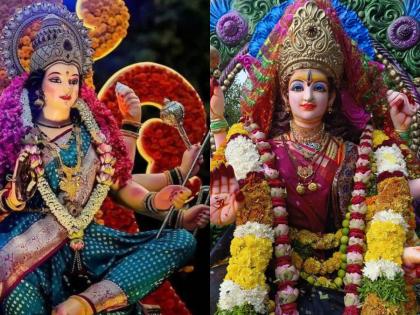Shardiya Navratri 2024: Date, Ghatasthapana Timing, Puja Vidhi, Nine Goddesses and Their Significance
By Lokmat English Desk | Updated: September 20, 2024 22:48 IST2024-09-20T22:45:34+5:302024-09-20T22:48:01+5:30
This year, the Pratipada date of Ashwin Shukla Paksha is from 12:18 AM on October 3 to 2:58 AM ...

Shardiya Navratri 2024: Date, Ghatasthapana Timing, Puja Vidhi, Nine Goddesses and Their Significance
This year, the Pratipada date of Ashwin Shukla Paksha is from 12:18 AM on October 3 to 2:58 AM on October 4. The auspicious time for Ghatasthapana on the first day of Navratri is from 6:15 AM to 7:22 AM. During Sharadiya Navratri, the most significant days are Mahashtami and Durganavami. Ashtami falls on October 11, followed by Mahanavami on October 12, 2024.
In the 2024 Shardiya Navratri 2024, Maa Durga will arrive on a palanquin, as the festival begins on a Thursday—a traditional sign that she comes to Earth in this manner. The nine Goddesses of Shardiya Navratri 2024 are Maa Shailputri, Maa Brahmacharini, Maa Chandraghanta, Maa Kushmanda, Maa Skandamata, Maa Katyayani, Maa Kalratri, Maa Mahagauri, and Maa Siddhidatri.
An Akhand Jyot is lit for the nine days of Navratri, with a ghee lamp on the right side of the Goddess and an oil lamp on the left. Sharadiya Navratri, a significant Hindu festival, is dedicated to the worship of Goddess Durga and her nine divine forms, collectively known as Navadurga. In 2024, this festival will commence on October 10 and conclude on October 18. Each day is dedicated to a specific form of the goddess, with unique rituals and significance associated with each avatar.
About 9 goddesses
The Navratri festival celebrates nine goddesses, each associated with specific attributes and rituals. Goddess Shailputri, representing purity, is honored with ghee offerings and the color orange on Day 1. Day 2 Goddess Brahmacharini, symbolizing devotion, with sugar-based offerings and the color white. On Day 3, Goddess Chandraghanta, the demon destroyer, receives kheer and the color red. Goddess Kushmanda, the universe's creator, is celebrated on Day 4 with malpua and royal blue.
Day 5 honors Goddess Skandamata, representing maternal love, with banana offerings and yellow. Goddess Katyayani, a warrior goddess, is revered on Day 6 with honey and green. Goddess Kalaratri, embodying fierceness, is worshipped on Day 7 with jaggery and grey. Day 8 highlights Goddess Mahagauri, symbolizing purity, with coconut offerings and purple. Finally, on Day 9, Goddess Siddhidatri, representing spiritual culmination, is honored with til seeds and the color peacock green.
Puja Vidhi (Rituals)
Ghatasthapana (Kalash Sthapana): This involves placing a pot filled with water and other auspicious items in a sanctified spot at home, symbolizing the goddess's presence.
Daily Offerings and Prasad: Each day's rituals involve specific offerings that align with the goddess being worshipped, often including sweets, fruits, or traditional dishes.
Chanting Mantras and Prayers: Devotees recite specific mantras dedicated to each goddess throughout the nine days to seek blessings and spiritual upliftment.
This festival not only celebrates the divine feminine but also encourages community participation through gatherings, prayers, and cultural activities across India.
Open in app